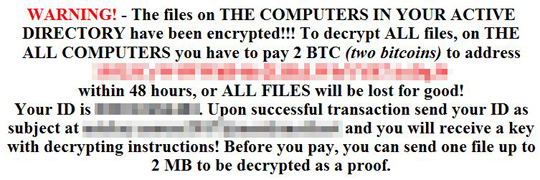RANSOM_AESBAT.A
Windows


Threat Type: Ransomware
Destructiveness: No
Encrypted: No
In the wild: Yes
OVERVIEW
Dropped by other malware
This Ransomware may arrive bundled with malware packages as a malware component.
It deletes itself after execution.
It encrypts files with specific file extensions. It drops files as ransom note.
TECHNICAL DETAILS
41,434 bytes
BAT
No
11 Oct 2017
Displays message/message boxes, Encrypts files
Arrival Details
This Ransomware may arrive bundled with malware packages as a malware component.
Process Termination
This Ransomware terminates processes or services that contain any of the following strings if found running in the affected system's memory:
- postgres.exe
- sqlwriter.exe
- sqlbrowser.exe
- sqlagent.exe
- sqlservr.exe
Other Details
This Ransomware requires the following additional components to properly run:
- aescrypt.exe
- eraser1.exe
- eraser.dll
It does the following:
- Execute the following commands:
- vssadmin.exe Delete Shadows /All /Quiet
- bcdedit /set recoveryenabled No
- bcdedit /set bootstatuspolicy ignoreallfailures
- DECRYPT_INSTRUCTIONS.html displays the following:

It deletes itself after execution.
Ransomware Routine
This Ransomware encrypts files with the following extensions:
- .docx
- .doc
- .xlsx
- .xls
- .csv
- .txt
- .dcm
- .dicom
- .zip
- .rar
- .tgz
- .jpg
- .jpeg
- .avi
- .mp4
- .mpeg
- .ppt
- .pptx
- .cfg
- .db
- .accdb
- .mdb
- .fdb
- .xml
- .myd
- .dbf
- .sql
- .mdf
- .accdt
- .accdc
- .crt
- .p7b
- .cer
- .crt
- .pfx
- .p12
- .pem
- .bak
- .bkf
- .tsbak
- .sav
- .cat
- .abd
- .abf
- .cfx
- .prproj
It drops the following file(s) as ransom note:
- {Encrypted file path}\DECRYPT_INSTRUCTIONS.html
SOLUTION
9.850
13.712.08
11 Oct 2017
13.713.00
12 Oct 2017
Step 1
Before doing any scans, Windows XP, Windows Vista, and Windows 7 users must disable System Restore to allow full scanning of their computers.
Step 2
Note that not all files, folders, and registry keys and entries are installed on your computer during this malware's/spyware's/grayware's execution. This may be due to incomplete installation or other operating system conditions. If you do not find the same files/folders/registry information, please proceed to the next step.
Step 3
Identify and terminate files detected as RANSOM_AESBAT.A
- Windows Task Manager may not display all running processes. In this case, please use a third-party process viewer, preferably Process Explorer, to terminate the malware/grayware/spyware file. You may download the said tool here.
- If the detected file is displayed in either Windows Task Manager or Process Explorer but you cannot delete it, restart your computer in safe mode. To do this, refer to this link for the complete steps.
- If the detected file is not displayed in either Windows Task Manager or Process Explorer, continue doing the next steps.
Step 4
Search and delete these files
- {Malware Path}\aescrypt.exe
- {Malware Path}\eraser1.exe
- {Malware Path}\eraser.dll
- {Encrypted file path}\DECRYPT_INSTRUCTIONS.html
Step 5
Scan your computer with your Trend Micro product to delete files detected as RANSOM_AESBAT.A. If the detected files have already been cleaned, deleted, or quarantined by your Trend Micro product, no further step is required. You may opt to simply delete the quarantined files. Please check the following Trend Micro Support pages for more information:
Step 6
Restore encrypted files from backup.
Did this description help? Tell us how we did.

